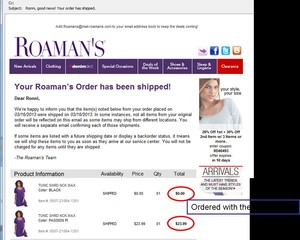Marketing Offer Overload
Customers Are Drowning in Repeat and Inappropriate Offers
Marketing success comes down to hitting the customer with an offer of something they want or need at the moment they want or need it. But too many marketers bombard customers with a glut of email offers, sometimes even multiple times a day. The result is that customers automatically delete the offers without ever looking at them. Here are some best practices that will help you avoid overwhelming your customers with offers.
NETTING IT OUT
We are all suffering from information overload, but making it even worse is marketing message overload. We are bombarded with emails offering us deals—often from merchants we don’t regularly do business with. But we know how to deal with them—we unsubscribe. But what about the glut of offers from the merchants we know and love? Are the constant offers hurting our relationships? Are we missing offers we might be interested in because they are hidden amongst the daily sale notices that we don’t care about?
There are some best practices you can follow to help assure your marketing messages get through and that they enhance, rather than hurt, your relationships with your customers:
- Implement touch control—how often each customer receives communications from you
- Avoid repetition—people tune out what they have already heard
- Provide appropriate offers—based on what you know about your customer and what the customer has explicitly told you
DEALING WITH INFORMATION OVERLOAD
Last month, I read an interesting blog post by Tony Zambito entitled “4 Buyer Trends That Will Shake Marketing in 2013.” In his February 24th post, Zambito identified as the first trend the notion that customers are getting smarter at filtering content they choose to view; so there is great danger your message might not get through. His suggestion? “Turn off the fire hose, please!”
I resonated to this “trend,” as he calls it, although I don’t think that it’s anything new. Buyers have been overwhelmed by marketing messages for years, and, if you are just getting started in planning a strategy for how to address this information overload, you are way behind!
As Zambito states, “The amount of information overload is increasing significantly. With over 2 billion Internet users active daily, to be heard above the constant din of clicks is a supreme challenge.” How true! We are constantly bombarded with marketing offers, and only a handful of them are welcome or appropriate. So many people I speak to complain that their inboxes are half full of offers that don’t interest them. However, the merchants sending these offers are ones that they have enjoyed doing business with in the past. Unfortunately, these merchants just don’t seem to know when to stop.
How many of you receive daily offers from providers that you do business with? Do you need those constant reminders that they are out there with good deals? No, you don’t.
You want to be notified when there is something special going on based on your interests, history, and relationship with the merchant. But you don’t want to be overwhelmed with those offers. Think about how often you automatically delete these marketing messages without giving them a second thought. Yet you don’t want to completely unsubscribe to email notifications because, when you are actually looking for what they offer, you would love to have a great deal.
Whither “Touch Control?”
Before email marketing—which is basically a free marketing distribution channel—marketers though a lot about touch control: how often they would call or send (via snail mail) offers, or “touch” the customer. Because there was a cost involved in doing this outbound marketing, it was very important that each marketing piece was as effective as possible. And marketers understood that constant bombardment of marketing offers was a turn off for most customers. They kept careful track of how often a customer received an offer—how often they were touched—so that there was no customer burn out. But now, with emails costing little to send, the rigor that used to be applied to touch marketing seems to have gone away. Pity!
Some organizations do a good job of allowing customers to limit the types of email communications that are sent by marketing, such as Amazon, which is an excellent example of the best practice in this area. (See Illustration 1.) But I have yet to find one that lets the customer select how often they are touched. Often, if you subscribe to email newsletters or discussion forums, you can easily decide whether you want to receive each communication as it is sent, or a daily digest, or a weekly digest, or a monthly digest. Why not apply that approach to marketing messages (obviously dropping out the time-sensitive communications in the weekly and monthly digests)?
Amazon.com Offers Advanced Marketing Communications Controls
© 2013 Amazon.com
1. Amazon lets customers select the categories about which they receive marketing communications. Customers can also control categorized email subscriptions. However, customers can’t specify how often they would like to receive marketing emails.
Avoid Constant Repetition
Not only are we drowning in marketing emails, many of them are repeat offers. If we received fewer offers, we might welcome a reminder about a great deal, but with the volume of marketing messages, repetition breeds contempt. If you send an offer at the beginning of the month that “the March Madness Sale gives you 20% off,” you don’t need to send it every day or even every week. Let the customer know the first day it is active, and then remind them in the middle of the month, and then send a last day notice. Some of my colleagues and friends would find that many reminders overbearing. But it’s better than daily harassment.
For example, I received an offer for “Knit BOGO-buy one get one free” from Roaman’s this past weekend. I like Roaman’s merchandise, so I took advantage of the offer. This morning, I received an email notification at 6:58 a.m. that my order has been shipped (see Illustration 2).
Notification of Shipment of Merchandise from Special Offer
© 2013 Patricia Seybold Group Inc. and Roaman’s.com
2. The shipping notification for the tunics I ordered with the “buy one get one free” offer from Roaman’s was received early Tuesday morning.
Then, at 7:57 a.m., I received the identical email offer for...
(Download the PDF for the entire article.)
Sign in to download the full article
0 comments
Be the first one to comment.





